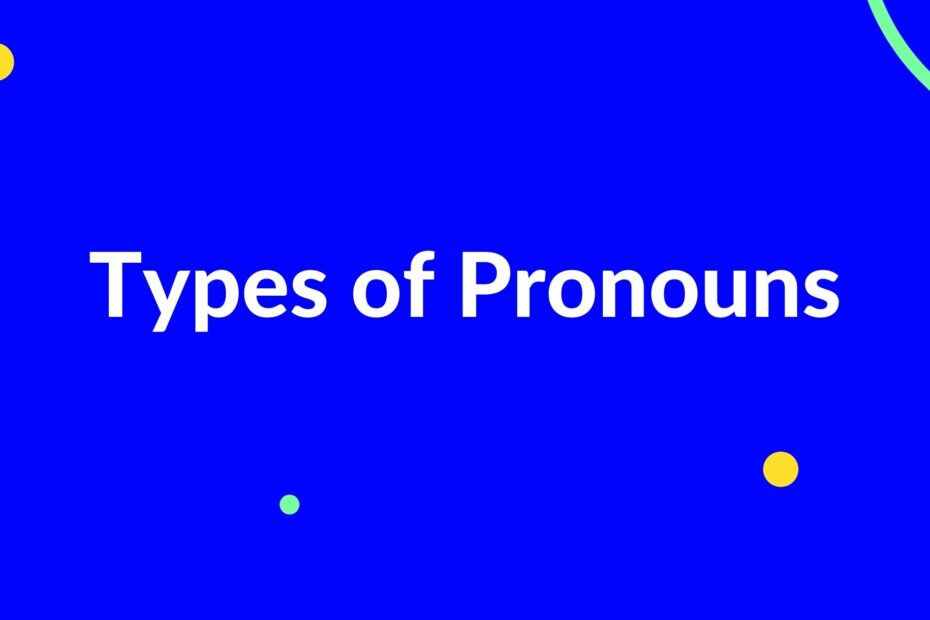There are 9 types of pronouns in the English language: personal pronouns, demonstrative pronouns, indefinite pronouns, interrogative pronouns, possessive pronouns, relative pronouns, reflexive pronouns, reciprocal pronouns, and intensive pronouns. Pronouns are words that replace nouns or represent people or things. Understanding types of pronouns is essential for any who wants to master English grammar.

1. Personal pronouns
Personal pronouns are words that refer to specific people or things. They can be used as the subject, object, or complement in a sentence. The use of personal pronouns can affect the way your writing is received. Personal pronouns:
- First Person (The Speaker)
I, My, Me / We, Our, Us.
- Second Person (The Listener)
You, Your You
- Third Person (Not Present)
He, His, Him / She, Her, Her / They, Their, Them / It, It / One, One’s, One.
Examples:
| Subjective case | Subjective case | Objective case |
|---|---|---|
| I | MY | ME |
| WE | OUR | US |
| YOU | YOUR | YOU |
| HE | HIS | HIM |
| SHE | HER | HER |
| THEY | THEIR | THEM |
| IT | ITS | IT |
Personal pronouns have main three categories:
- First Person (The Speaker)
I, My, Me / We, Our, Us.
- Second Person (The Listener)
You, Your You
- Third Person (Not Present)
He, His, Him / She, Her, Her / They, Their, Them / It, It / One, One’s, One.
2. Demonstrative pronouns
Demonstrative pronouns are words that point to and identify a noun or a pronoun. We use demonstrative pronouns to indicate distance in time or space. The four demonstrative pronouns are this, that, these, and those. This and that are used to point to one item (singular) or one group of items (plural). These and those are used to point to more than one item (plural).
Here are some examples of demonstrative pronouns:
- Are you sure this is your pen?
- That is my cousin and his sister.
- These are my favorite bikes and cars.
- These are my nephews, Jimmy and Johnny.
- Those are expensive cottages.
3. Indefinite pronouns
An indefinite pronoun is a pronoun that refers to some unspecified thing or group of things. Indefinite pronouns do not refer to a specific person or thing. The most common indefinite pronouns are all, any, anyone, anything, each, everybody, everyone, everything, few, many, nobody, none, one, several, some, and someone.
Examples:
- Nothing matters if you fail, matter how you work.
- I have everything that I could ever want.
- No one can help me in the present age.
4. Interrogative pronouns
Interrogative pronouns are used to ask questions. They can be used to ask for information or to confirm something. The most common interrogative pronouns are: who, what, where, when, why, and how. To use them, you simply add them to the beginning of a question.
Examples:
- Who has got a job in English Department?
- Whom did she blame and why?
- What happened? Why are you carrying?
5. Possessive pronouns
Possessive pronouns are words that indicate who owns or is associated with an item. For example, “That book is mine.” Possessive pronouns can stand alone or be used as part of a longer phrase. The possessive pronouns are mine, yours, his, hers, its, ours, and theirs. Examples:
The cat slept on its bed.
This computer is mine.
Are those your gloves?
His jacket was on the floor.
6. Relative pronouns
A relative pronoun is a pronoun that introduces a relative clause. A relative clause is a clause that provides additional information about a noun or pronoun in the sentence. The relative pronouns are who, whom, whose, which, and that.
- Who and whom are used to refer to people.
- ‘Whose’ is used to show possession.
- ‘Which’ is used to refer to things.
- ‘That‘ is used to refer to people or things.
Here are some examples:
The man who called yesterday is coming back today. ( introduces a relative clause that provides additional information about the man)
I don’t know the person to whom you are speaking. ( introduces a relative clause that provides additional information about the person)
7. Reflexive pronouns
A reflexive pronoun is a word that refers back to the subject of a sentence or clause. In other words, it is a pronoun that is used as an object to refer to the same subject that is represented by the pronoun. For example, “I cut myself.” or “She cut herself.”
Reflexive pronouns are important to use in order to avoid ambiguity. For example, if you said “I hit him,” it’s unclear if you hit someone else or if you hit yourself. However, if you said “I hit myself,” it’s clear that you performed the action of hitting on yourself. Reflexive pronouns are typically formed by adding -self or -selves to a pronoun, as seen in the examples above.
Reflexive Pronouns include Ourselves, Yourself, Himself, Herself, Themselves, Itself, Oneself.
Examples:
- She cut herself with the cutlass.
- I see myself becoming a singer.
- Why was the dog licking itself?
8. Reciprocal pronouns
Reciprocal pronouns are used to refer to two or more people who are doing the same thing. The reciprocal pronouns are “each other” and “one another.” For example, “The couple smiled at each other” We can also use reciprocal pronouns to describe two things that are happening at the same time. For example, “The leaves were falling off the trees and the wind was blowing them around.”
9. Intensive Pronouns
Intensive pronouns (sometimes called emphatic pronouns) are used to emphasize the noun or pronoun to which they refer. The intensive pronouns are me, yourself, himself, herself, itself, ourselves, yourselves, and themselves. The intensive pronouns are the same as the reflexive pronouns, but they are used differently. Intensive pronouns are used in a variety of situations, but most often appear in cases where the speaker is drawing attention to a particular noun. For example, if I say “I’m the one who should get the credit,” the word “I” is functioning as an intensive pronoun.
Conclusion
We use types of pronouns every day without giving them a second thought. Keep in mind that there are 9 types of pronouns: personal pronouns, demonstrative pronouns, indefinite pronouns, interrogative pronouns, possessive pronouns, relative pronouns, reflexive pronouns, reciprocal pronouns, and intensive pronouns. Be sure to choose the right pronoun for the context of your sentence. Thanks for reading!

